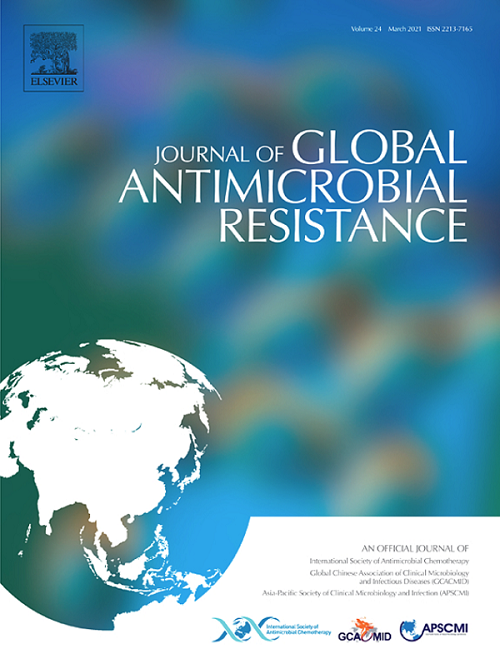Genomic characterisation of the first case of IMP-13-producing carbapenem-resistant Pseudomonas aeruginosa ST313/ExoU+/O1 isolate in Chile
IF 3.2
3区 医学
Q2 INFECTIOUS DISEASES
引用次数: 0
Abstract
Objective
Carbapenemase-resistant Pseudomonas aeruginosa (CR-PA) is a WHO priority pathogen posing a serious public health threat. This study reports the first IMP-13-producing P. aeruginosa isolate (150UDEC/24) in Chile, recovered from a bone infection in April 2024.
Methods
Antimicrobial susceptibility was determined using disk diffusion and MIC strip tests. Whole-genome sequencing (WGS) was performed on the Illumina NovaSeq platform, and annotation by the NCBI PGAP. Analyses included Staramr, VFDB, MLST, PAst, MOB-Typer, MOB-Recon, and Integron Finder2. Phylogenetic analysis of 150UDEC/24 and 44 ST313 genomes was carried out by IQTree and iTOL for visualization.
Results
The 150UDEC/24 isolate exhibited resistance to relevant antibiotics, including cephalosporins and carbapenems (imipenem, meropenem). It belonged to sequence type (ST) ST313 and serotype O1 and harboured multiple resistance genes: aph(6)-Id, aph(3′’)-Ib, aph(3′)-IIb, aac(6′)-Ib4, aph(3′)-VI, catB7, dfrB3, sul1, fosA, blaOXA-488, blaOXA-2, blaPDC-37, and blaIMP-13. The blaIMP-13 gene was embedded in a class 1 integron alongside dfrB3, aac(6′)-Ib4, and blaOXA-2. Additionally, the virulence gene exoU was detected. Phylogenetic analysis showed 150UDEC/24 diverged from other ST313 strains, with no other isolate carrying blaIMP-13, suggesting distinct evolution.
Conclusions
This study provides the first genomic characterization of an IMP-13-producing ST313 carbapenem-resistant P. aeruginosa isolate (150UDEC/24) in Chile, containing multiple resistance genes and the ExoU virulence factor. Phylogenetic analysis suggests unique evolution, emphasizing the need for continued genomic surveillance to monitor the emergence of highly resistant, virulent strains in clinical settings.
智利首例产imp -13的耐碳青霉烯类铜绿假单胞菌ST313/ExoU+/O1分离株的基因组特征
目的:耐碳青霉烯酶铜绿假单胞菌(CR-PA)是世界卫生组织列为严重公共卫生威胁的重点病原体。本研究报告了智利第一个产imp -13的铜绿假单胞菌分离物(150UDEC/24),该分离物于2024年4月从骨感染中恢复。方法:采用纸片扩散法和MIC试纸法测定药敏。全基因组测序(WGS)在Illumina NextSeq平台上进行,并由NCBI PGAP进行注释。分析包括Staramr、VFDB、MLST、PAst、MOB-Typer、MOB-Recon和Integron Finder2。采用IQTree和iTOL软件对150个udec /24和44个ST313基因组进行系统发育分析。结果:150UDEC/24菌株对头孢菌素类药物和碳青霉烯类药物(亚胺培南、美罗培南)均有耐药性。它属于序列型(ST) ST313和血清型O1,含有多个耐药基因:aph(6)-Id、aph(3’)-Ib、aph(3’)-IIb、aac(6’)-Ib4、aph(3’)-VI、catB7、dfrB3、sul1、fosA、blaOXA-488、blaOXA-2、blaPDC-37和blaIMP-13。blaIMP-13基因与dfrB3、aac(6')-Ib4和blaOXA-2一起嵌入在1类整合子中。此外,还检测到毒力基因exoU。系统发育分析表明,150UDEC/24与其他ST313菌株存在分化,没有其他分离株携带blaIMP-13,提示进化过程不同。结论:本研究首次对智利产的ST313耐碳青霉烯P. aeruginosa分离物(150UDEC/24)进行了基因组鉴定,该分离物含有多种耐药基因和ExoU毒力因子。系统发育分析显示了独特的进化,强调需要继续进行基因组监测,以监测临床环境中出现的高耐药性、强毒性菌株。
本文章由计算机程序翻译,如有差异,请以英文原文为准。
求助全文
约1分钟内获得全文
求助全文
来源期刊

Journal of global antimicrobial resistance
INFECTIOUS DISEASES-PHARMACOLOGY & PHARMACY
CiteScore
8.70
自引率
2.20%
发文量
285
审稿时长
34 weeks
期刊介绍:
The Journal of Global Antimicrobial Resistance (JGAR) is a quarterly online journal run by an international Editorial Board that focuses on the global spread of antibiotic-resistant microbes.
JGAR is a dedicated journal for all professionals working in research, health care, the environment and animal infection control, aiming to track the resistance threat worldwide and provides a single voice devoted to antimicrobial resistance (AMR).
Featuring peer-reviewed and up to date research articles, reviews, short notes and hot topics JGAR covers the key topics related to antibacterial, antiviral, antifungal and antiparasitic resistance.
 求助内容:
求助内容: 应助结果提醒方式:
应助结果提醒方式:


